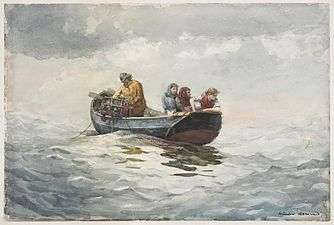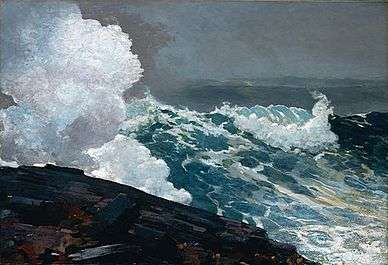The Fog Warning
| The Fog Warning | |
|---|---|
 | |
| Artist | Winslow Homer |
| Year | 1885 |
| Medium | Oil on canvas |
| Dimensions | 76 cm × 122 cm (30 in × 48 in) |
| Location | Museum of Fine Arts, Boston, Boston, U.S. |
The Fog Warning is one of several paintings on marine subjects by the late-19th-century American painter Winslow Homer (1836–1910). Together with The Herring Net and Breezing Up, painted the same year and also depicting the hard lives of fishermen in Maine, it is considered among his best works on such topics.[1][2][3]
Background
After initially making his reputation with paintings on themes related to the Civil War, in the late 1860s and through the 1870s Winslow Homer turned instead to painting people relaxing and at play: children, young women, genre paintings of farm and sea scenes. In 1881–82 he spent time in Cullercoats, in northeast England, and on his return to the US, settled for good in Prout's Neck, Maine, where his father and brother had recently purchased a large amount of land. His brother had spent his honeymoon in Prout's Neck in 1875, and Winslow had visited him then.[4] In both these locations he returned to painting the sea with more serious themes, the hard and dangerous lives of the fishermen and their families, and "humankind’s life-and-death struggles against the sea and the elemental power of nature" throughout the rest of his career.[4]
He had a studio built for him in Prout's Neck, which was completed in 1884. Here he painted The Fog Warning, one of his three best paintings he completed there in 1885 depicting the lives of the local fishermen. These are considered among his best; the others are Lost on the Grand Banks, and The Herring Net.[1][2][3] Many of his late paintings, like The Fog Warning, depict a single figure at sea.[2] Another theme in many of his paintings of the fisherman's life was the bounty of the sea, which also provides the people's livelihood; the two are combined in this painting, which was originally exhibited under the title Halibut Fishing.[2]
Description

The painting depicts a lone fisherman in a dory who has caught several halibut but now sees fog blowing up, threatening to cut him off as he rows back to his ship. His face is turned in profile to the viewer as he looks over his shoulder at the streamers of fog in the background.[1][2] The Boston Fine Art Museum gives this description:
The Fog Warning is a painting with a narrative, though its tale is disturbing rather than charming. As indicated by the halibut in his dory, the fisherman in this picture has been successful. But the hardest task of the day, the return to the main ship, is still ahead of him. He turns to look at the horizon, measuring the distance to the mother ship, and to safety. The seas are choppy and the dory rocks high on the waves, making it clear that the journey home will require considerable physical effort. But more threatening is the approaching fog bank, whose streamers echo, even mock, the fisherman's profile.[1]
The scene is psychologically tense; the risk of being lost at sea as a result of a sudden fog was all too real at the time, and the viewer does not know whether this man will reach his ship in time.[1] The picture has been used in elementary-school education to teach about interpretation of art and fishermen's lives.[5]
Studies
Several studies for the painting survive, among them a more intimate, less monumental version called Halibut Fishing.[6] Homer's handyman Henry Lee posed for the painting in a dory supported on a pile of sand.[6]
Thematically related works
In addition to Herring Nets and Breezing Up, which share the focus on Maine fishermen, Homer's Lost on the Grand Banks (also 1885) and After the Hurricane, Bahamas 1899 depict tragedy at sea: the former another fisherman in mortal danger at sea, the latter one thrown up on shore dead. In contrast, in Summer Night (1890) the sea is raging in the background while in the middle ground people silhouetted against the waves watch, but in the foreground two girls are dancing, unconcerned.
- Other marine paintings by Winslow Homer
 Crab Fishing, 1873
Crab Fishing, 1873 Three Boys in a Dory with Lobster Pots, 1875
Three Boys in a Dory with Lobster Pots, 1875_-_Google_Art_Project.jpg)
 Sunlight on the Coast, 1884
Sunlight on the Coast, 1884 The Herring Net, 1885
The Herring Net, 1885.jpg) Summer Night, 1890
Summer Night, 1890
References
- 1 2 3 4 5 "The Fog Warning: Halibut Fishing, 1885". Museum of Fine Arts, Boston. Retrieved September 27, 2014.
- 1 2 3 4 5 "The Fog Warning, 1885 by Winslow Homer". Winslow Homer.org. Retrieved September 27, 2014.
- 1 2 "The Herring Net, 1885 by Winslow Homer". Winslow Homer.org. Retrieved September 27, 2014.
- 1 2 "About Winslow Homer". Portland Museum of Art. Retrieved September 27, 2014.
- ↑ Hurwitz, Al; Day, Michael (2006). Children and Their Art: Methods for the Elementary School. Cengage Learning. p. 405.
- 1 2 Middendorf, John William (1967). American Paintings & Historical Prints from the Middendorf Collection: A Catalogue of an Exhibition. Metropolitan Museum of Art / Baltimore Museum of Art. p. 52. OCLC 1014725.
Further reading
- Cooper, Helen A., Winslow Homer Watercolors, p. 16. Yale University Press, 1986.
- Nicolai Cikovsky, Jr., Winslow Homer, Harry N. Abrams, New York, 1990, pp. 11–13, ISBN 0-8109-1193-0
- Elizabeth Johns, Winslow Homer: The Nature of Observation, University of California Press, Berkeley, 2002, p. 9, ISBN 0-520-22725-5
- Randall C. Griffin, Winslow Homer: An American Vision. Phaidon Press, New York, 2006, ISBN 0-7148-3992-2
- Paul Raymond Provost, Winslow Homer's The Fog Warning: The Fisherman as Heroic Character, Kennedy Galleries, 1990
External links
 | |
|
|
-
 Media related to The Fog Warning at Wikimedia Commons
Media related to The Fog Warning at Wikimedia Commons - Video from Smarthistory about The Fog Warning